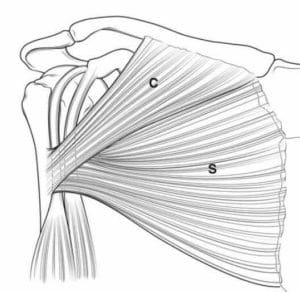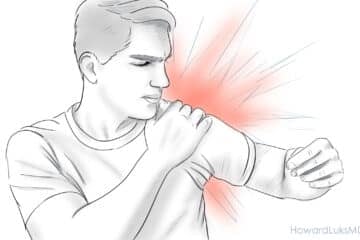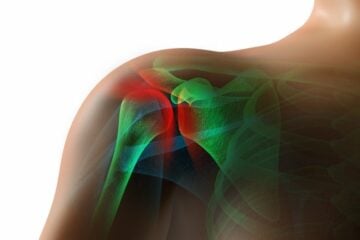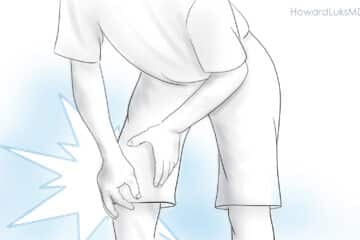
The pectoral tendon attaches the pec major muscle to your humerus or arm bone. The pec major is a very powerful muscle. Pectoral tendons are usually ruptured or torn in weight lifters during bench pressing. Traumatic injuries in sports can also result in a pec tendon tear. Surgery is often needed to repair complete pec tears. The recovery after surgery often means that this is a season-ending injury.
A torn pectoral tendon is usually an easy diagnosis to make. Your story usually goes something like this… You were bench pressing, you heard a series of pops and the bar came back down to your chest rapidly. If that sounds familiar, you have likely torn a pectoral tendon or have pectoralis major rupture. Over the next few days, you will notice heavy bruising and swelling. As the swelling starts to subside, you will see a deformity of your pectoralis major. If you tighten your chest muscles you will see the pec ball up over your chest. A torn pectoral should be repaired (if it is repairable) as soon as possible. If you suspect a pec tendon injury you should see a shoulder doc sooner rather than later.
A torn pectoral tendon tends to occur in “younger” active weight lifters. However, because 50 somethings are lifting more often and more weight we are seeing pec tears in this age group as well. This is an injury we usually see rapidly in our clinic since the injury is quite striking, the deformity is easy to notice and the story you give is always consistent. There is usually significant bruising present and there is usually an obvious deformity noted as your pec major bunches up in your chest.
Like J.J Watt, a torn pec tendon can occur in any collision sport as well. This will be a season-ending injury for Watt. What is the decision making and recovery time frame going forward for J.J Watt and others who have torn their pec tendon?

Types Of Torn Pectoral Tendons?
Tears of the pectoralis major can be partial (just one head) or complete.
In type 1 torn pectoral, the tendon of the pectoralis major tears directly off of the humerus – the easiest to fix.
In type 2 torn pectoral the tear occurred where the muscle starts transitioning into a tendon – the muscle-tendon junction- harder to fix, but still possible.
In type 3 pec ruptures, the tear is completely within the muscle itself. May not be repairable.
In type 4 pec ruptures, the muscle tears off of the sternum.
A Type 1 or Type 2 pec tear is far more common than type 3 or 4.
How Do You Treat A Torn Pectoral Tendon?
Most pec major tendon ruptures occur in very active people. Without surgery, pectoralis major tears will cause weakness and an obvious deformity. Because of that, most people with a pec tear will choose to have them repaired. The pec major is not an absolutely essential muscle, and many of these pec tears are partial tears, so if the loss of strength and the deformity do not bother you then you can be treated without surgery.
How Do You Repair A Torn Pectoral Tendon?
If you choose to have surgery to repair your pec tendon tear then you should understand the following principles.
Type 1 tears where the tendon ripped off the bone are the most straightforward to repair. The surgery is open, and the incision is placed in your axilla. During the surgery, we will use a suture anchor device to place sutures into the bone and then we will use those sutures to repair the tendon back to the bone. You will be in a sling for a while and then start strengthening exercises after enough healing has occurred.
Type 2 tears are more difficult. These tears occur at the “muscle-tendon” junction of the pec major. Muscle tendon junction tears can be very difficult to fix because you can not sew or repair muscle. Often times we wait a little while for some early repair scar tissue to form on the pec muscle which will make the repair easier. Sometimes we might need to augment or strengthen the repair with a cadaver tendon.
Type 3 tears are purely within the muscle. They are very rare and very hard to repair. We must wait a few weeks for scar tissue to form so we have something we can attempt to repair.
Most tears are Type 1 or 2, so most tears are easily repairable. The results of surgery are generally good, and most of you will be pleased with the appearance of the pectoralis and your performance in the gym after you have recovered.
How Long Does Is Recovery From A Torn Pectoral Tendon?
Pectoralis tears generally heal very well. It can take at least 6 months until you are back in the gym and back to your normal routine. It can take a year or more until you have normal strength, although that might occur earlier in many of you.
What Are The Risks Of A Pec Tendon Repair?
No surgery is without risk. The risks include the risks of anesthesia, infection, weakness, stiffness, a recurrent pectoral rupture, an abnormal appearance, nerve or blood vessel injuries.
The overall risks of surgery are very low. Below is a video detailing how a pectoral tendon tear is repaired.














Dear Dr. Luks,
I’m writing to inquire about how long is too long to wait to have a torn pec repaired. Approximately 5 1/2 years ago I tore some portion of my left pec while doing a heavy bench press that I wasn’t fully warmed up for. Based on your descriptions, it seems like a pretty standard tear: pop, severe pain, bruising, and a bunched up muscle which flexes like a little ball on my chest. I was deployed overseas at the time and unable to get immediate care beyond pain meds. Six months later when i returned I saw a doctor to ask for surgery, but he said that the tear wasn’t a complete tear and that surgery wouldn’t help. However, it seemed that he simply didn’t have experience with it. Either way, I resided myself to the fact that i’d only have 1 fully functioning pec. This had a majorly negative impact on my sports training over the last several years. I’m reaching the limitations of what I can do with it, and i’m afraid the imbalance will cause other problems. Is 6 years too late to repair it? Would it be worth my time to seek out a surgeon who has experience with this?
Thank you,
Jake W.
Most of us consider 2-3 weeks a long time. The pec tendon tends to scar down in its new home making a repair difficult. Late reconstructions are perhaps considered possible by some, but the results are often less than satisfactory– esp 5 years after the initial injury.
Hi Dr. Luks,
I have a type 2 pec tear from 5 weeks ago. Is it possible for the muscle to repair/regenerate back to normal for a symmetric chest without surgery?
Thanks
Unfortunately no
Dr. Luks,
I believe I have torn my pec, I have had my MRI and my orthopedic doctor can’t quite figure out if it’s completely torn, or where its torn. We are waiting for the radiologist to look at it. I’m just worried about whether or not it’s a type 1 tear or type 2. Is there any way I can determine that by looking or feeling?
Sometimes we can tell by examination… but the MRI or ultrasound is critical to show the site of a pec rupture.
Dr. Luks,
While bench pressing 6 days ago my right arm gave out after I felt a snap on my right shoulder. It was not very painful but I went to the hospital immediately. I saw a doctor and he had me push against his hand and raise my arm. He felt around my pec and said he could not feel the tear and since I could push with my arm and raise it it was not fully torn and surgery was not necessary. The next few days my bicep was black and blue and chest was sore . There is a slight asymmetry between my two pecs but it seems to be getting better everyday. In your opinion, what should I do? He doctor said it was very minor, can the muscle and tendon connection regenerate? Thanks so much.
Best,
Anthony
Have it looked at sooner rather than later. If it is torn it needs to be treated within a few weeks of injury for best possible results.
Partial tears will not have same appearance as full tears and can fool some folks on examination.
Hi Anthony, That is similar to what happened to me. Two doctors told me I was probably ok and one said even though there was tearing I didn’t need surgery. I knew something was wrong because when I picked up my arm like I was flexing my bicept (fist by my temple and elbow out away from my body)💪 the outside of my pec felt soft where it used to be hard. A sports medicine doc had me get an x ray and MRI. The MRI showed a complete tear of my pectorals major. I just had surgery on it two days ago ( about three weeks after it happened). My orthopedic surgeon said you can do the repair up to two years After the injury occurs. It seems that the MRI is what tells you what’s really happened more than anything else since I was not in severe pain and could put pressure against the docs hands as well. I could even do a push-up although it was painful.
Dr Luks:
I was just diagnosed with a tear of the myotendinous junction of the sternum head of the pec major with slight medial retraction. The distal tendon fibers remain intact. The injury occurred 4 months ago and due to my schedule I would prefer to have surgery in 3 months. Is this what you call a type 2 tear? Does waiting an additional 3 months matter? Can I incur additional injury by working out over the next 3 months? Any other advice? Many thanks.
The longer you wait the more difficult it often is to repair.